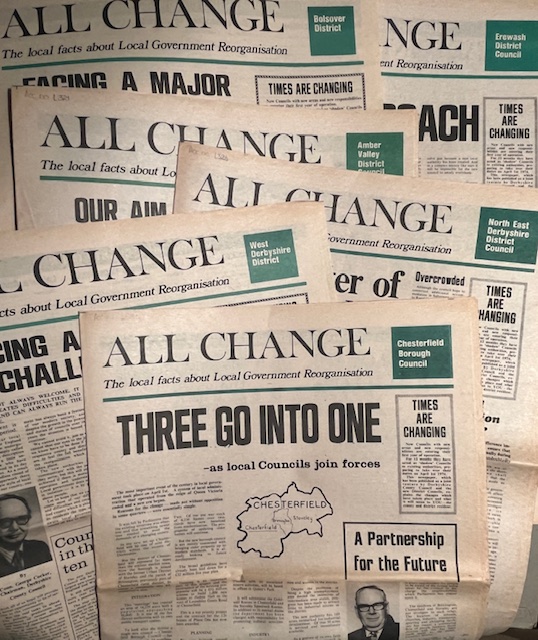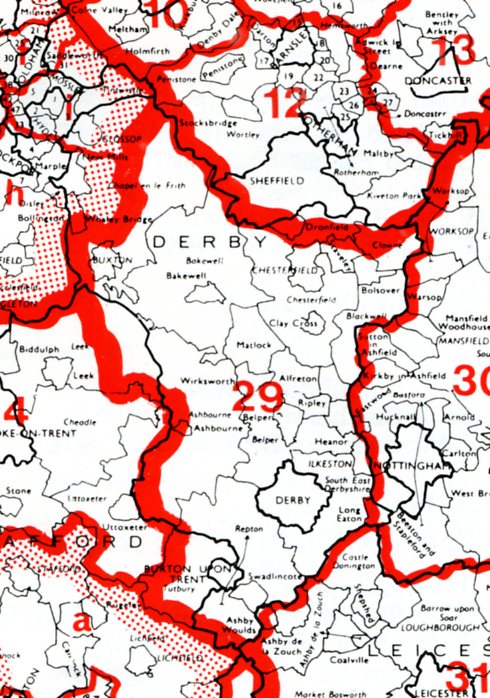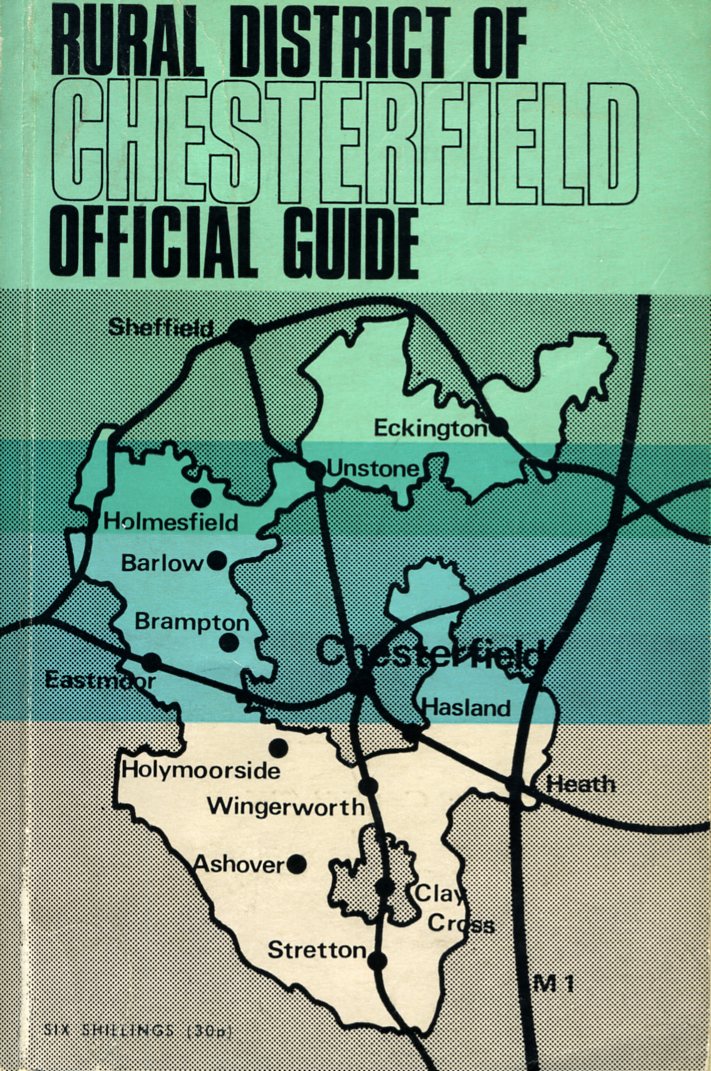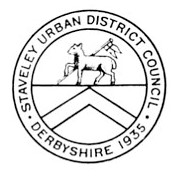In this post we take a look at a largely and perhaps surprisingly unmarked event – the great changes to local government across England and Wales which occurred on 1 April 1974. We’ll focus particularly on the Chesterfield area.
The pattern of local government

Until April 1974 the pattern of local government in England had comprised city, town, rural districts, urban districts, parish and county councils. Staveley residents, for example, were served by Staveley Urban District Council, whilst those in Brimington sat in Chesterfield Rural District Council’s area as did other nearby parishes such as Ashover, Barlow, Brampton, Calow, Hasland, Heath, Sutton-cum-Duckmanton, Temple Normanton, Unstone, North Wingfield Walton and Wingerworth. There were 23 parishes (all with parish councils) in the Chesterfield rural district.
Chesterfield’s borough council is of ancient descent – see our chronology of Chesterfield’s history, which traces the corporation’s development. It was classed as a non-county borough and an ‘accepted district’ for education, which meant it administered primary and secondary education within its boundary. Prior to the April 1974 reorganisation the council comprised not only elected councillors but also 12 ‘Aldermen’ – who were elected by the councillors and other aldermen. There were aldermen on the county council too, but not on urban or rural district councils!
Overall perhaps a confusing picture.
Changes proposed
The changes had been fairly long in coming. Lord Redcliffe-Maud had presented the findings of a Royal Commission into local government to Parliament in June 1969. There had been thoughts that the then present system of local government, largely based on patterns established in the 19th century, was not fit-for-purpose.
We’ve reproduced an extract from one of the plans showing the Redcliffe-Maud report’s proposed pattern of local government for ‘counties’ in this post.

Aggrieved by the proposals
Some local communities were much aggrieved by moves to place them outside the county. Barlborough is just one example – where a transfer into what was then described as ‘Sheffield and south Yorkshire’. The report had concluded that the parish, along with three others in the Chesterfield rural district, were ‘so much under the influence of Sheffield’ that they should be included in the ‘Sheffield unit’. Barlborough fought a notable campaign against the proposals, but there were others too.

More local to Chesterfield, Brimington was generally seen as being happy with its position in Chesterfield Rural District Council. Many in Staveley were not pleased with proposals which would see an end to their urban district status and combination, with Brimington, into a much larger Chesterfield district council.
The plans also ended up creating some county authorities that were less than universally welcomed – such as Avon and Humberside. Both were abolished in 1996 and replaced by unitary (all purpose) authorities.
The Local Government Act of 1972 brought in the finally agreed proposals for both England and Wales and a period of transition followed. Elections for shadow authorities were held the following year.

A new era begins

On March 31 1974, thirty former authorities across the county came to an end – including all the former rural and urban districts, the county borough of Derby and the county council. They were replaced with a new county council and nine district councils. Parish councils were not changed, but resultant unparished areas in the abolished districts could apply to become a parish (also termed town) council. This ultimately occurred in Staveley’s case.
Some functions, previously undertaken by districts, were transferred to the county council. This included responsibility for all schools, libraries and highways (though Chesterfield retained an agency agreement for some years with the county for the latter). Other services, such as water and health services were transferred to regional bodies. Many long-serving officers and councillors decided to retire at the same time of the reorganisation.
The county boundary did not generally change (apart from a minor redrawing bringing Tintwhistle into Derbyshire). Consequently, the community campaigns ‘to remain in Derbyshire’ may be judged to have been a success.
Locally a new North East Derbyshire District Council was formed by the merger of the former Clay Cross and Dronfield Urban District Councils and all the former Chesterfield Rural District Council parishes – except Brimington. Staveley Urban District Council, with the former parish of Brimington and all the former Chesterfield borough, were united to form a new Chesterfield Borough Council.
More changes
Since 1974 more changes have taken place, but have not been as radical and made at one time as those on 1 April 1974.
Some county authorities, such as that mostly envisaged as ‘Unit 12’ in the Redcliffe-Maud report – and indeed established for south Yorkshire, have come and gone. As have the days of passenger transport executives directly running bus services (resulting in the one time cheap bus fares policy in south Yorkshire). Then the Local Government Act of 1992 came resulting in further changes. Locally there have also been some small-scale adjustments to boundaries since 1974. Nationally there has been a move towards ‘unitary authorities’, with abolition of county authorities and creation of these all purpose bodies.
Powers of local councils have also changed, and there has an undoubted cut in funding from central government. But today there seems to be a move back to give local councils more powers to run things such as buses, with directly elected regional mayors also figuring. It remains to be seen whether or not these changes are both understood, necessary and sustainable and whether or not the scale of the great changes made in 1 April 1974 will ever be repeated.

Sources used in this blog
- ‘All change- the local facts about local government reorganisation’ 1974. (A series of local ‘newspapers’ publicising the change to local government. Published jointly by the new county and district councils).
- Barlborough Historical Society ‘History of Barlborough’s campaign to remain in Derbyshire’ 1973
- Borough of Chesterfield [council] diary 1973-74
- Borough of Chesterfield guide c.1959.
- Brimington and Tapton Local History Group ‘Road sign points to local government’s past in Brimington’ blog post originally published 4 November 2021.
- Chesterfield Rural District Council, ‘Official guide’ 1970 and 1972
- City of Sheffield ‘Sheffield: emerging city’ 1969
- North East Derbyshire District Council, ‘Official guide’ 1977
- Derbyshire County Council ‘Our first annual report 1974-75’ 1975.
- Staveley Urban District Council ‘Staveley Official Guide’ c.1966.
This post was edited on 3 April 2024 to remove some typos and clarify some illustration captions.
